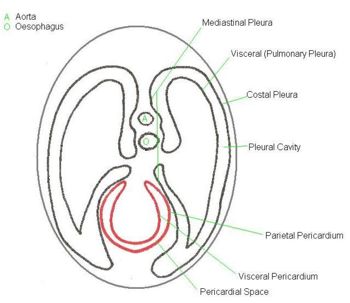Difference between revisions of "Pleural Cavity and Membranes - Anatomy & Physiology"
Jump to navigation
Jump to search
| Line 23: | Line 23: | ||
*The Heart is invested in a Parietal and Visceral layer of '''Pericardium''' with the '''Pericardial Space''' separating the two membranes. | *The Heart is invested in a Parietal and Visceral layer of '''Pericardium''' with the '''Pericardial Space''' separating the two membranes. | ||
*Cranially the Costal and Mediastinal Pleura adjoin to form a 'dome' of pleura which extends cranially to the thoracic inlet. This is known as the '''Cupulae Pleurae'''. This region is only protected by soft tissue, and thus is vulnerable to injury. | *Cranially the Costal and Mediastinal Pleura adjoin to form a 'dome' of pleura which extends cranially to the thoracic inlet. This is known as the '''Cupulae Pleurae'''. This region is only protected by soft tissue, and thus is vulnerable to injury. | ||
| − | * | + | *Within the pleural sac encasing the right lung, there is a fold which encases the Vena Cava. It is known as the '''Plica Venae Cavae'''. |
| − | + | *The Pleural Membranes are larger than the lungs which they encase, thus there are areas where the facing surfaces of parietal pleura touch eachother. These are known as '''Pleural Recesses'''. One example is the '''Costodiaphragmatic Recess''', the space between the costal and diaphragmatic pleura. The volume of the recess varies to a point due to the phase of inspiration/expiration. | |
| − | * | + | ===Pleural Membrane Function=== |
| + | |||
| + | *The pleural membranes are partially protective | ||
==Vasculature== | ==Vasculature== | ||
| Line 46: | Line 48: | ||
==Species Differences== | ==Species Differences== | ||
| − | *In '''Cattle''' the Mediastinum is a tough membrane, in contrast to '''Horses''' where it is rather thin and more delicate. | + | *In '''Cattle''' the Mediastinum is a tough membrane, in contrast to '''Horses, Dogs''' and '''Cats''' where it is rather thin and more delicate. |
==Links== | ==Links== | ||
Revision as of 11:18, 13 August 2008
|
|
Introduction=
Pleural Membranes
The surface of the inner wall of all of the body cavities are lined by a serous membrane which consists of a single layer of flat epithelium with a thin underlying propria (connective tissue). Within the thoracic cavity, this is known as the Pleura.
Structure of the Pleural Membranes
- Each lung is placed within a separate layer of membrane, thus there are two pleural sacs.
- The space between the two sacs is known as the Mediastinum, and is almost in the midline of the thorax.
- The pleura covering the surface of the lung is known as Pulmonary Pleura or Visceral Pleura. This becomes continuous with the Mediastinal Pleura as it wraps around the lung.
- The Diaphragmatic and Costal Pleura are continuous with the Mediastinal Pleura. Together, these three membranes are the Parietal Pleura.
- Between the Parietal and Visceral Pleura is the Pleural Cavity. This contains a small amount of serous fluid which establishes adhesion between the layers and allows smooth movement between the lung and chest wall, and between individual lobes of the lungs.
- The Heart is invested in a Parietal and Visceral layer of Pericardium with the Pericardial Space separating the two membranes.
- Cranially the Costal and Mediastinal Pleura adjoin to form a 'dome' of pleura which extends cranially to the thoracic inlet. This is known as the Cupulae Pleurae. This region is only protected by soft tissue, and thus is vulnerable to injury.
- Within the pleural sac encasing the right lung, there is a fold which encases the Vena Cava. It is known as the Plica Venae Cavae.
- The Pleural Membranes are larger than the lungs which they encase, thus there are areas where the facing surfaces of parietal pleura touch eachother. These are known as Pleural Recesses. One example is the Costodiaphragmatic Recess, the space between the costal and diaphragmatic pleura. The volume of the recess varies to a point due to the phase of inspiration/expiration.
Pleural Membrane Function
- The pleural membranes are partially protective
Vasculature
Innervation
Lymphatics
Histology
Species Differences
- In Cattle the Mediastinum is a tough membrane, in contrast to Horses, Dogs and Cats where it is rather thin and more delicate.
Links
References
- Dyce, K.M., Sack, W.O. and Wensing, C.J.G. (2002) Textbook of Veterinary Anatomy. 3rd ed. Philadelphia: Saunders.
- Budras, K.D., McCarthy, P.H., Fricke, W. and Richter, R. (2002) Anatomy of the Dog. 4th ed. Hannover: Schlutersche GmbH & Co. KG, Verlag und Druckerei.
